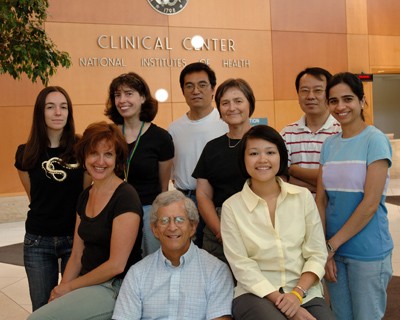Our Science – Hodes Website
Richard J. Hodes, M.D.
 |
|
|||||||||||||||||||||
Biography
Dr. Hodes received his M.D. from Harvard Medical School and completed a research fellowship at the Karolinska Institute in Stockholm and clinical training in internal medicine at Massachusetts General Hospital before coming to the NIH. He is chief of the Immune Regulation Section of the Experimental Immunology Branch as well as director of the National Institute on Aging.
Research
Cellular and Molecular Regulation of Immune Response
The Role of Costimulatory Receptors in Lymphocyte Activation. A primary area of interest in this laboratory is the study of costimulatory molecules and their function. Costimulation has been extensively studied in the T cell receptor (TCR)-mediated activation of mature T cells. In recent efforts, we have focused on analysis of costimulatory function in T cell development, homeostasis, and effector function. Findings include:
- CD28 costimulation by B7-1 (CD80) and B7-2 (CD86) plays a substantial role in homeostasis of CD4 and CD8 T cell subsets. Using mice genetically engineered to be either overexpressing or deficient in B7, we have shown that modulation of B7 expression results in profound alterations in the homeostasis of peripheral CD4 and CD8 cells.
- Both CD40/CD40L-dependent and -independent pathways mediate negative selection of self-reactive T cells. The function of CD40/CD40L and B7/CD28 costimulatory interactions in negative selection was studied using mice deficient in one or more of these molecules. We demonstrated that a CD40/CD40L-dependent pathway mediates negative selection of CD4 and CD8 thymocytes and that this pathway is independent of B7 and CD28. A second path of negative selection is CD40/CD40L-independent and acts late in differentiation of CD4 but not CD8 single positive T cells.
- CD28/B7 interactions play an important role in tolerance induction in CD8 T cells. The requirements for costimulation in CD8 T cell tolerance were analyzed for the first time in TCR transgenic mice in vivo. We found that CD28 and B7 are required for both clonal deletion and clonal hyporesponsiveness, demonstrating a critical role for this costimulatory pathway in tolerance induction.
- The CD80/86-CD28 and CD40-CD40 ligand costimulatory pathways are essential for T-dependent B cell immune responses. We determined that these two pathways are non-redundant and are mediated through distinct mechanisms. The function of CD80/86-CD28 costimulus in B cell activation is cell autonomous, whereas the function of CD40-CD40L is non-cell autonomous.
- Current studies are directed at further analyzing the influence of costimulatory molecules on T cell selection and tolerance. These studies have identified striking effects of costimulation on critical check-points in thymic development and are using genetic manipulation to elucidate the molecular mechanisms mediating these effects.
Regulation of Lymphocyte Replicative Capacity: Telomere Length and Telomerase Expression in the Immune System.
A second major interest of this lab is the study of mechanisms determining replicative capacity of T and B lymphocytes. This work has analyzed the role of telomerase and telomere length regulation. It had previously been reported that malignant tumors and germline cells, but not normal somatic cells, express telomerase, and it was proposed that this accounts for selective immortality of germline and cancer cells. On this background, studies tested the hypotheses that telomere length differs as a reflection of replicative history and that T and B cells express telomerase as a mechanism for extending replicative capacity. Recent findings are:
- Telomerase activity is highly regulated during activation and development of T and B lymphocytes, and this regulation is mediated by both transcriptional and posttranslational mechanisms. We have shown that both components of telomerase, RNA template (TER) and catalytic reverse transcriptase (TERT), are regulated at the level of steady-state RNA during T and B cell development and activation. In addition, we demonstrated that telomerase activity is regulated by novel posttranslational mechanisms that may be related to TERT phosphorylation and nuclear translocation.
- Telomere length in normal somatic cells is genetically regulated. We have shown that differences in telomere length between mouse species are regulated by a single recessive locus on distal chromosome 2. These findings demonstrated that increases in telomere length can occur during normal differentiation.
- Telomere length in vivo is regulated by telomerase expression. We have recently shown that telomere length is regulated by expression of telomerase RNA template (TER), and have demonstrated haploinsufficiency in telomere maintanence in heterozgous TER knock-out mice. We have now generated both knock-out and transgenic models of telomerase reverse transcriptase (TERT) expression to further assess function in vivo.
The role of telomerase expression and telomere length maintenance have been studied in T cell responses in vitro and in vivo. During responses to protein antigens or to viral infection, telomerase activity is induced in a highly specific manner in antigen-reactive T cells, and is sustained in long-term memory cells. Telomere length is maintained in T cells during primary responses, long-term memory, and secondary response. These findings suggest that telomerase-dependent telomere maintenance plays an important role in supporting the replicative capacity of antigen-reactive T cells.
- A recombinase-associated gene (Rag)-dependent mechanism mediates TCR translocation in thymic lymphomagenesis in mice deficient for the ataxia telangiectasia mutated (ATM) gene. ATM plays a role in repair responses to double-strand DNA breaks and influences telomere maintenance. We have characterized the role of ATM in Rag-dependent and Rag-independent recombination in tumorigenesis and have shown a role for ATM in Ig class switch recombination.
- Current efforts will extend analysis of the relationship between telomerase activity and control of telomere function, and the relationship of these variables to replicative capacity. Systems have been established that will use transgenic and knock-out mice to elucidate the role of telomerase and telomere length maintenance in somatic cell function, with specific focus on lymphocyte biology.
This page was last updated on 6/11/2008.

